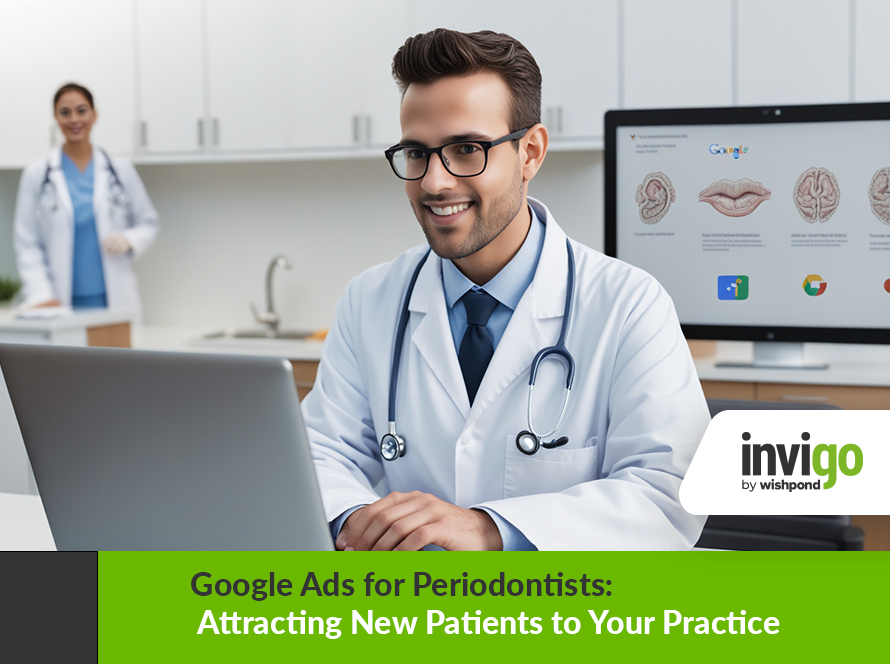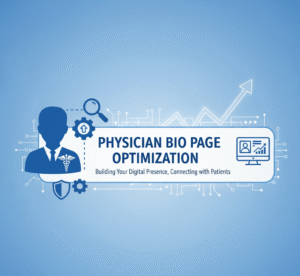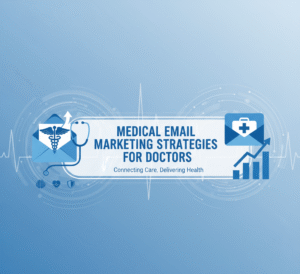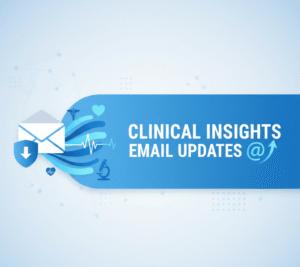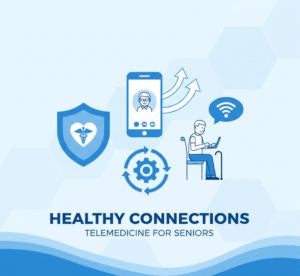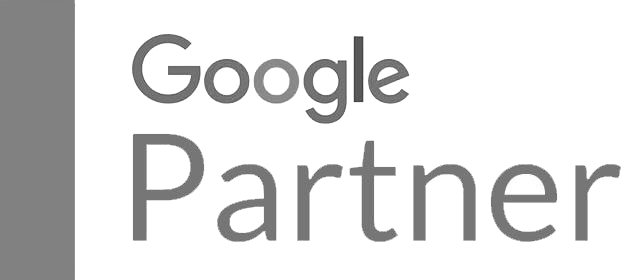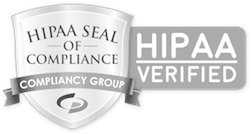“Discover how Google Ads for periodontists can drive new patients to your practice with targeted PPC, real-time insights from Invigo’s EverGenius, and expert strategies for growth.”
In today’s competitive healthcare landscape, attracting new patients is a constant challenge for periodontists. The days of relying solely on word-of-mouth or traditional advertising are long gone. Now, digital visibility is paramount. That’s where Google Ads comes into play, offering a powerful, targeted way to reach individuals actively searching for periodontal services. This article will explore the immense benefits of leveraging Google Ads to expand your patient base, focusing on how precision-engineered pay-per-click (PPC) campaigns can significantly boost your practice’s visibility and convert more leads into loyal patients. We will also explore how cutting-edge tools and expert strategies can optimize your ad performance, provide real-time insights, and ultimately improve your return on investment. Furthermore, we’ll touch upon the synergistic role of other digital strategies, such as Facebook Ads, and underscore why choosing the right partner, like Invigo Media, is crucial for sustained growth.
The Digital Frontier: Why Google Ads is Essential for Periodontists
Think about how most people find information these days. When someone has a health concern, their first instinct is often to “Google it.” This behavior presents a golden opportunity for your periodontist practice. Unlike traditional advertising, which casts a wide net, Google Ads lets you directly connect with individuals already expressing a need for your services. They are actively searching for “gum disease treatment,” “dental implants near me,” “periodontist consultations,” or similar terms. This intent-based targeting is incredibly powerful, putting your practice in front of the right people when they are looking for solutions.
The Power of Intent: Reaching Patients at the Right Moment
Imagine a potential patient experiencing gum discomfort. They open their browser and type “bleeding gums treatment” into Google. If your practice has a well-optimized Google Ad campaign, your ad could appear at the top of the search results. This immediate visibility means your practice is the first solution they see, often even before organic search results. This isn’t just about showing up; it’s about showing up first and relevantly.
This intent-driven approach means you’re not just hoping to catch someone’s attention but responding to a direct query. This drastically increases the likelihood of a click, a call, and ultimately, a new patient.
Beyond Search: A Wider Reach with Google Ads
Google Ads isn’t confined to just Google Search. It extends its reach across a vast network, including Google Display Network (GDN), YouTube, and Gmail. This expansive reach allows for various ad formats and targeting options, enabling your practice to engage with potential patients at different stages of their online journey.
For instance, display ads on the GDN can showcase your practice with visually appealing banners on relevant websites, perhaps those related to health and wellness. YouTube ads can reach a younger demographic or those who prefer video content, allowing you to explain complex procedures engagingly. Gmail ads can appear at the top of users’ inboxes, subtly promoting your services. This multi-faceted approach ensures your practice’s message resonates across diverse online platforms.
The Anatomy of a Successful Google Ad Campaign for Periodontists
Building an effective Google Ad campaign isn’t simply about throwing money at the problem. It requires a strategic approach, meticulous planning, and ongoing optimization. Let’s break down the key components.
Keyword Research: The Foundation of Visibility
The cornerstone of any successful Google Ads campaign is thorough keyword research. This involves identifying potential patients’ specific words and phrases when searching for periodontal services. For a periodontist, this might include:
- “gum disease treatment”
- “dental implant specialist”
- “Gingivitis treatment”
- “periodontal surgery”
- “bone grafting dental”
- “Receding gums cure”
- “bad breath dentist” (as it can be a symptom of periodontal issues)
- “laser gum surgery”
- “periodontist near [city/zip code]”
It’s crucial to consider broad terms and long-tail keywords (more specific phrases) to capture a wider range of search queries. Negative keywords are also vital. These are terms you don’t want your ads to show up for. For example, a periodontist might add “free dental checkup” as a negative keyword if they don’t offer that service, preventing irrelevant clicks.
Compelling Ad Copy: Crafting Your Message
Once you have your keywords, the next step is to write compelling ad copy. Your ad text needs to be concise, informative, and persuasive. It must grab attention and communicate the value your practice offers. Consider including:
- Strong Call to Actions (CTAs): Phrases like “Schedule Your Consultation,” “Call Now for an Appointment,” or “Visit Our Website” guide the user to the next step.
- Unique Selling Propositions (USPs): What makes your practice stand out? Do you offer state-of-the-art technology, specialized expertise, or an exceptionally comfortable patient experience? Highlight these.
- Relevance to the Search Query: Ensure your ad copy addresses the user’s search intent. For example, if they searched for “dental implants,” mention them in your ad.
- Conciseness: Google Ads has character limits, so every word counts.
Landing Page Optimization: The Conversion Hub
When someone clicks on your ad, where do they go? This is your landing page. It’s not enough to simply send them to your general website homepage. A dedicated landing page, tailored to the specific ad and the user’s search intent, is crucial for conversion.
A well-optimized landing page should:
- Be relevant: The content should directly relate to the ad the user clicked on.
- Be clear and concise: Avoid jargon and get straight to the point.
- Have a clear Call to Action: Make it easy for the user to schedule an appointment, fill out a form, or call your office.
- Be mobile-friendly: A significant portion of searches happen on mobile devices.
- Load quickly: Slow loading times lead to high bounce rates.
- Showcase your expertise and credibility: Include patient testimonials, doctor bios, and before-and-after photos (if appropriate and compliant with regulations).
Bid Management and Budget Allocation: Smart Spending
Google Ads operates on a bidding system. You set a maximum bid: the amount you will pay per click. Effective bid management involves understanding your cost per acquisition (CPA) and optimizing bids for the best ROI.
Budget allocation is equally essential. You need to determine how much you’re willing to spend daily or monthly and distribute that budget strategically across your campaigns and ad groups. This isn’t a “set it and forget it” process; it requires ongoing monitoring and adjustments based on performance data.
Geographic Targeting: Reaching Your Local Community
For a periodontist, local patients are the lifeblood of the practice. Google Ads allows for precise geographic targeting, ensuring your ads are shown only to people within a specific radius of your office or in particular cities, states, or neighborhoods. This minimizes wasted ad spend and focuses your efforts on your most relevant audience.
Ad Extensions: More Space, More Information
Ad extensions provide additional information and functionality to your ads, making them more prominent and valuable to potential patients. These can include:
- Sitelink extensions: Link to specific pages on your website, like your “Services” page or “About Us.”
- Call extensions: Display your phone number directly in the ad, allowing users to call with one click.
- Location extensions: Show your business address and a map, helping users find your practice.
- Structured snippet extensions highlight specific features or services, such as “Dental Implants,” “Gum Disease Treatment,” or “Cosmetic Periodontics.”
- Callout extensions: Add brief, non-clickable text snippets to highlight unique selling points like “Experienced Periodontists” or “Advanced Technology.”
Using ad extensions effectively can significantly increase your ad’s click-through rate (CTR) and provide a better user experience.
Beyond the Basics: Advanced Google Ads Strategies for Periodontists
Once you have the fundamental campaign elements, you can move on to more sophisticated strategies to maximize your results.
Remarketing: Re-Engaging Interested Prospects
Not everyone who visits your website or clicks on your ad will convert immediately. Remarketing (also known as retargeting) allows you to show ads to people who have previously interacted with your website or your Google Ads. This is incredibly powerful because you’re targeting individuals who have already demonstrated interest in your services.
For example, suppose someone visits your “Dental Implants” page but doesn’t schedule a consultation. In that case, you can show them remarketing ads about dental implants, featuring patient testimonials or special offers. This keeps your practice top-of-mind and encourages them to take the next step.
Competitor Targeting: Learning from the Best (and Beating Them)
While not always a direct strategy, understanding your competitors’ Google Ads strategies can provide valuable insights. You can analyze their ad copy, keywords, and landing pages to identify opportunities and refine your campaigns. However, focus on what makes your practice unique rather than simply mimicking others. The goal is to stand out.
Google My Business Integration: Local SEO Synergy
For periodontists, local search is paramount. Optimizing your Google My Business (GMB) profile is crucial for local organic search and integrates seamlessly with Google Ads. Ensuring your GMB profile is complete, accurate, and regularly updated with photos, reviews, and posts can significantly enhance the effectiveness of your local ad campaigns. This combined approach creates a powerful regional presence.
The Crucial Role of Data and Analytics: Optimizing for Success
Launching a Google Ads campaign is just the beginning. The real magic happens with continuous monitoring, analysis, and optimization. Data is your most valuable asset here.
Tracking Key Performance Indicators (KPIs)
To understand what’s working and what isn’t, you need to track relevant KPIs:
- Impressions: How many times was your ad shown?
- Clicks: How many times was your ad clicked?
- Click-Through Rate (CTR): The percentage of impressions that resulted in a click (Clicks / Impressions). A higher CTR indicates more relevant and compelling ads.
- Cost Per Click (CPC): The average price for each click.
- Conversions: The number of desired actions users take, such as phone calls, form submissions, or appointment requests.
- Conversion Rate: The percentage of clicks that resulted in a conversion (Conversions / Clicks).
- Cost Per Acquisition (CPA): Acquiring one new patient or lead. This is a critical metric for ROI.
- Return on Ad Spend (ROAS): The revenue generated for every ad dollar spent.
A/B Testing: Continual Improvement
A/B testing involves creating multiple versions of your ads, landing pages, or bidding strategies and running them simultaneously to see which performs best. For instance, you have two headlines for an ad or two variations of a landing page CTA. This iterative process of testing and refining leads to incremental but significant improvements over time.
Invigo Media: Your Partner in Periodontist Practice Growth
Navigating the complexities of Google Ads, especially within the highly regulated healthcare industry, can be daunting. This is where an experienced partner like Invigo Media becomes invaluable. They specialize in digital marketing for healthcare providers, understanding the nuances of medical policy and effective patient acquisition strategies.
Invigo Media brings a wealth of expertise, offering a comprehensive suite of services designed to maximize your Google Ads ROI and drive new patients to your periodontist practice.
Invigo’s EverGenius Platform: Real-Time Insights and AI-Powered Optimization
One of Invigo Media’s standout offerings is its EverGenius platform. This cutting-edge tool goes beyond standard analytics, providing real-time insights into your campaign performance. It leverages artificial intelligence to analyze vast data, identifying trends and opportunities that human analysis might miss.
EverGenius can:
- Predict patient behavior: Understand when potential patients are most likely to convert.
- Optimize bidding strategies: Automatically adjust bids to get the most conversions for your budget.
- Identify underperforming keywords or ads: Quickly flag areas that need attention.
- Provide actionable recommendations: Translate complex data into clear steps you can take to improve your campaigns.
This platform empowers your practice with data-driven decision-making, ensuring your ad spend always works as efficiently as possible.
Call Tracking: Connecting Clicks to Conversations
For a periodontist practice, phone calls are often the primary conversion point. Patients want to speak with someone to schedule appointments, ask questions, or understand procedures. Invigo Media incorporates call tracking into its strategies, providing invaluable insights into which ads and keywords generate phone calls.
Call tracking allows you to:
- Attribute calls to specific campaigns: Know which ad led to a phone call.
- Record calls (with patient consent): Review calls for quality assurance, staff training, and understanding patient needs.
- Track call duration: Differentiate between quick information calls and substantive inquiries.
- Identify peak call times: Optimize staffing to handle incoming patient inquiries.
This level of detail means you’re not just tracking clicks; you’re tracking genuine patient engagement, helping you refine your campaigns to generate more high-quality leads.
PPC Expertise: Navigating the Complexities
The world of PPC is constantly evolving. Google frequently updates its algorithms, policies, and ad formats. Staying on top of these changes requires dedicated expertise. Invigo Media’s team comprises seasoned PPC specialists who live and breathe Google Ads. They understand the intricacies of ad auctions, quality scores, and the ever-changing landscape of online advertising.
Their PPC expertise ensures:
- Compliance with Google Ads Healthcare Policy: Navigating the stringent rules around medical advertising to avoid account suspensions or penalties.
- Strategic campaign setup: Building campaigns from the ground up for maximum effectiveness.
- Ongoing optimization: Continuously monitoring and adjusting campaigns to improve performance.
- Problem-solving: Quickly addressing any issues or challenges that arise.
- Staying ahead of the curve: Implementing new features and best practices as they emerge.
This dedicated expertise allows your practice to focus on what you do best – providing exceptional periodontal care – while Invigo Media handles the complexities of your digital advertising.
Google Ads Healthcare Policy: Understanding the Rules
Operating within the healthcare sector means adhering to strict guidelines set by platforms like Google. Google’s Healthcare and Medicines policy aims to protect users and ensure responsible advertising. For periodontists, this means understanding certain limitations and requirements.
Key aspects of the policy include:
- Transparency: Ads must be clear and not misleading.
- Data Privacy: Strict rules regarding collecting and using sensitive health information.
- Restricted Content: Certain types of content, such as unproven or experimental treatments, may be prohibited.
- Geographic Restrictions: Some medical services might have limitations based on country-specific regulations.
- Certifications: In some regions, Google may require advertisers to be certified to run certain healthcare-related ads.
An experienced agency like Invigo Media is well-versed in these policies, ensuring your campaigns remain compliant and effective, avoiding potential pitfalls that could lead to ad disapprovals or account suspensions.
Beyond Google Ads: A Synergistic Digital Marketing Approach
While Google Ads is undeniably powerful, a robust patient acquisition strategy often involves a multi-channel approach. Integrating Google Ads with other digital marketing efforts creates a synergistic effect, amplifying your reach and impact.
Facebook Ads: Building Brand Awareness and Targeting Demographics
While Google Ads captures intent, Facebook Ads excels at reaching specific demographics and building brand awareness. People on Facebook aren’t actively searching for a periodontist; they’re scrolling through their feeds. However, Facebook’s extensive targeting capabilities allow you to reach individuals based on:
- Demographics: Age, gender, location, and income level.
- Interests: People interested in health, wellness, dental care, or even specific conditions like diabetes (which can impact gum health).
- Behaviors: Recent moves, life events.
- Custom Audiences: Uploading your existing patient list to create lookalike audiences.
Facebook Ads can be used for:
- Brand awareness campaigns: Introducing your practice to a broader audience.
- Educational content: Sharing information about periodontal health, treatment options, and prevention.
- Special offers: Promoting new patient specials or specific services.
- Remarketing: Reaching individuals who visited your website or interacted with your Facebook page.
The visual nature of Facebook also allows for compelling video and image ads, showcasing your practice environment, patient testimonials, or educational animations about procedures.
Content Marketing: Becoming an Authority
Creating valuable content – blog posts, articles, videos, infographics – positions your practice as a trusted authority in periodontal health. This content can be optimized for search engines (SEO) to attract organic traffic and shared on social media. For example, a blog post on “Signs You Might Have Gum Disease” can educate potential patients and subtly guide them towards your services. This approach builds trust and nurtures leads over time.
Search Engine Optimization (SEO): Organic Visibility
While Google Ads provides immediate visibility through paid placement, SEO focuses on improving your website’s organic ranking in search results. A strong SEO strategy for a periodontist would involve:
- On-page SEO: Optimizing your website content, meta descriptions, and headers with relevant keywords.
- Technical SEO: Ensuring your website is fast, mobile-friendly, and easily crawlable by search engines.
- Local SEO: Optimizing your Google My Business profile, building local citations, and acquiring local reviews.
- Off-page SEO: Building high-quality backlinks from other reputable websites.
SEO is a long-term strategy, but it provides sustainable organic traffic that complements your paid advertising efforts.
Reputation Management: The Power of Reviews
In the digital age, online reviews are incredibly influential. Potential patients often check reviews before choosing a healthcare provider. Encouraging satisfied patients to leave reviews on Google, Yelp, and other platforms and actively responding to positive and negative feedback is crucial for building trust and attracting new patients. A strong online reputation significantly boosts the effectiveness of your Google Ads.
Case Study: A Periodontist’s Success Story with Google Ads
Let’s illustrate the impact with a hypothetical example. Dr. Anya Sharma, a periodontist in a mid-sized city, struggled to consistently acquire new patients despite offering top-tier services. Her website received some organic traffic, but wasn’t translating into enough appointments. She decided to partner with Invigo Media to launch a Google Ads campaign.
Invigo Media started by conducting in-depth keyword research, identifying terms like “dental gum specialist,” “periodontal treatment,” and “implants for missing teeth” as high-intent keywords in her service area. They crafted compelling ad copy highlighting Dr. Sharma’s expertise and compassionate approach. Crucially, they developed dedicated landing pages for each key service, featuring patient testimonials and an easy-to-use appointment request form.
Within the first month, Dr. Sharma saw a significant increase in website traffic and phone calls. Invigo’s EverGenius platform provided real-time data, showing which keywords drove the most valuable leads. Call tracking revealed that patients searching for “gum grafting specialist” were consistently converting into appointments. Based on these insights, Invigo adjusted bids and reallocated budget to optimize for these high-value keywords.
Over the next few months, Dr. Sharma’s new patient acquisition rate jumped by 40%. The ROI on her Google Ads spend was demonstrably positive, and she expanded her practice, bringing on another dental hygienist to accommodate the increased patient volume. This success was a direct result of the strategic targeting, data-driven optimization, and expert management provided by Invigo Media.
The Bottom Line: Invest in Your Practice’s Future
For periodontists, Google Ads is not just an advertising channel; it’s a strategic investment in your practice’s future. It offers unparalleled precision in reaching individuals seeking your services and converting intent into appointments. However, maximizing this potential requires more than a basic understanding of the platform. It demands expert knowledge, continuous optimization, and access to advanced tools.
Partnering with a specialized agency like Invigo Media, with their EverGenius platform, robust call tracking, and profound PPC expertise, provides your periodontist practice with a distinct competitive edge. They navigate the complexities of Google Ads, ensure compliance with healthcare policies, and continually refine their campaigns to deliver tangible results: more visibility, leads, and ultimately, more new patients.
Don’t let potential patients scroll past your practice. Embrace the power of Google Ads and unlock a new era of growth for your periodontist practice.
FAQs
Q1: What is Google Ads, and how does it work for periodontists?
Google Ads is an online advertising platform where businesses bid to display concise ads to users searching for specific keywords on Google. For periodontists, it works by placing your practice’s ads in front of individuals actively searching for periodontal services like “gum disease treatment” or “dental implants.” When users click on your ad, they are directed to your website or a specific landing page, where they can learn more about your services and schedule an appointment. You pay a fee each time someone clicks on your ad (hence “pay-per-click” or PPC).
Q2: Why is Google Ads more effective than traditional advertising for a periodontist?
Google Ads is highly effective because it targets users based on their immediate intent. Unlike traditional advertising (e.g., billboards, newspaper ads), which cast a wide net, Google Ads allows you to reach people actively searching for the exact services you offer. This means less wasted ad spend and a higher likelihood of attracting qualified leads who are ready to book an appointment. It also provides detailed analytics, allowing for continuous optimization.
Q3: How does Google Ads Healthcare Policy affect my periodontist practice’s campaigns?
Google Ads has specific policies for advertising healthcare-related services to protect users and ensure responsible advertising. These policies regulate the content of your ads and data privacy practices and, in some cases, may require specific certifications. Ensuring your ads are transparent, not misleading, and comply with all regional regulations is crucial for periodontists. An experienced agency like Invigo Media is well-versed in these policies, helping you navigate them effectively and avoid potential ad disapprovals or account suspensions.
Q4: What is Invigo’s EverGenius platform, and how does it help periodontists with Google Ads?
Invigo’s EverGenius platform is an AI-powered tool to optimize Google Ads campaigns for healthcare practices. It provides real-time insights by analyzing vast amounts of data, helping to identify trends and opportunities. EverGenius can predict patient behavior, optimize bidding strategies, identify underperforming keywords or ads, and offer actionable recommendations. This means your periodontist practice can make data-driven decisions, maximizing your ad spend for the best possible ROI.
Q5: How important is call tracking for a periodontist’s Google Ads campaign?
Call tracking is essential for a periodontist’s Google Ads campaign because phone calls are a primary conversion point for healthcare services. Call tracking lets you see which ads, keywords, and campaigns generate phone calls to your office. It provides data on call duration and peak call times and can even record calls (with patient consent). This information is invaluable for refining your campaigns, focusing your budget on what generates actual patient inquiries, and understanding patient needs more deeply.
Q6: Can Google Ads help me target specific types of patients, like those seeking dental implants?
Absolutely. Google Ads allows for exact targeting. Through detailed keyword research, you can bid on terms like “dental implants near me,” “full mouth dental implants cost,” or “all-on-4 dental implants.” You can also use geographic targeting to reach patients in your service area. Furthermore, remarketing campaigns can target individuals who have previously visited the dental implant section of your website, further increasing the likelihood of conversion.
Q7: What other digital marketing strategies should a periodontist consider alongside Google Ads?
While Google Ads is powerful, a comprehensive digital marketing strategy for a periodontist should also include:
- Search Engine Optimization (SEO): To improve your organic search rankings and attract free, qualified traffic.
- Facebook Ads: These are used to build brand awareness, target demographics, and share educational content.
- Content Marketing: Creating valuable blog posts, articles, and videos to establish your expertise and attract potential patients.
- Reputation Management: Actively managing and soliciting online reviews to build trust and credibility.
- Website Optimization: Ensuring your website is user-friendly, mobile-responsive, and has clear calls to action.
Combining these strategies creates a robust online presence, reaching potential patients at various stages of their decision-making process.
Q8: How long does it take to see results from Google Ads for a periodontist practice?
While initial results, such as increased website traffic and clicks, can be seen relatively quickly (within days or weeks of launching a campaign), significant and consistent new patient acquisition typically takes a few weeks to a few months. This is because campaigns need time from your marketing partner to accumulate, analyze, and optimize data. The more data gathered, the better the campaign can be refined for optimal performance and ROI. Patience and consistent investment are key to long-term success.

